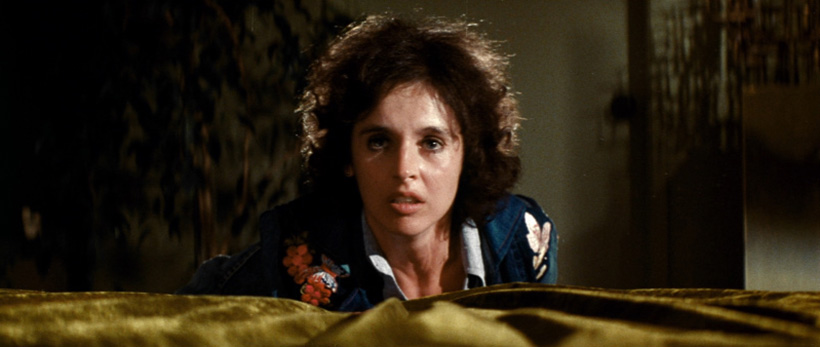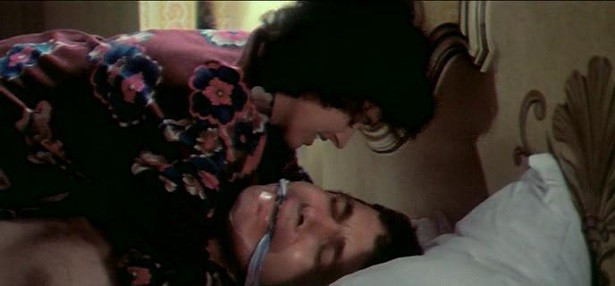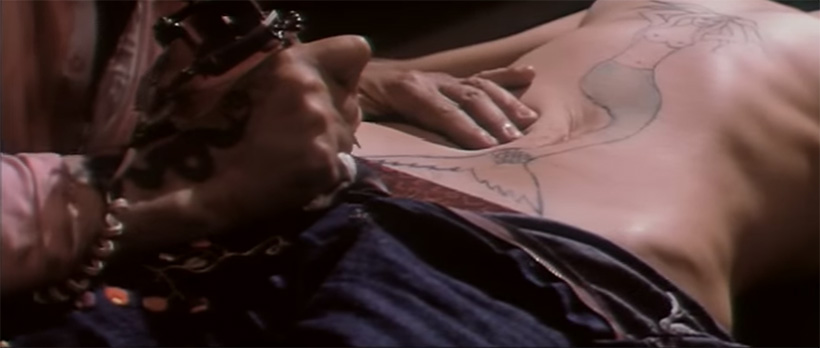Why don’t you act like a man and go hide in the closet, cowboy?

Doubling down on yesterday’s light horror entry, I’ve decided to go full on 1970s for tonight’s film. For those unfamiliar, the seventies boasted some of the finest independent horror films, and also some of the genuinely disturbing. I’ve said it before on this very blog, there’s just something about this decade that really creeps me out. Whether it’s the grainy look and feel of real film, the ubiquitous browns and beiges on an already saturated colour scheme, or just the fact that filmmakers of this era just had more of an axe to grind.
The last point applies fairly well to The Witch Who Came From The Sea (1976), a story that dwells in the disturbed mind of a woman still haunted by the sexual abuse she suffered as a child. So disturbing was it, that over here in the UK, it was firmly placed in the video nasty category, its uncut release coming as late as 2006. I happen to be watching on the beautifully restored Arrow Video Blu-Ray release, which is a must buy for dedicated followers of the video nasty genre.
So What Happens?
It’s a classically grim, seventies day at the beach for Molly (Millie Perkins) and her nephews. While supervising the two boys, Molly is increasingly distracted by a group of bodybuilders at work further down the beach. While watching, she begins to have disturbing visions of horrific accidents – each of the well toned, muscular men getting tangled up in chains or falling to their deaths.
It is just a vision, however, and Molly returns to tell her nephews stories of their late grandfather – Molly’s father – who was a sea captain and, therefore, remains a position of respect for her, as it should the boys. This is all relevant. Later, the group pause outside a tattoo parlour, and Molly becomes fixated on the tattoo of a mermaid before they are startled by the terrifying visage of the parlour’s owner, a heavily tattooed man called Jack Dracula (Stan Ross).
Throughout the film, Molly consistently becomes fixated on men, including those on the television, whom she identifies as looking like her father. Her visions get stronger over time, with the actors seemingly speaking directly to her – inviting her to join them in their fictional world. While with her sister Cathy (Vanessa Brown), Molly turns to drink as soon as the vision is over. While cradling her vodka, flashes of memory go through her mind.
In one such scene, Molly reminisces over a sexual encounter with two men. Their voices distorted, as if under water, we witness as Molly tears her shirt into strips, tying each of the men to the bed posts. As one passes out, she teases and taunts the other before escalating to the next level. He begins to panic as she gags them and begins to sing songs of the sea, while pulling out a razor blade and… yeah. To the director’s credit, we don’t witness any cutting, but the shots are composed in such a way as to make it even more disturbing. Oh, the seventies. Don’t ever change.

This, however, establishes the tone of the story. Molly is clearly disturbed, and often takes to drink. Through flashbacks and visions, we witness Molly’s disturbing hobbies and activities, each involving a sexual encounter and a gruesome climax. In time, Molly returns to the tattoo parlour by the beach, and has the same mermaid tattoo that she was so fixated on at the beginning – the same that her father had before her. We then begin to see the truth of the past, with some genuinely uncomfortable flashes of the sexual exploitation Molly suffered at the hands of her father. In her own words, “We got lost at sea so many, many times.”

The disturbing truth, as it is revealed, is that despite the abuse she suffered, Molly thinks of her father as perfect – the ideal man. Half mumbled references to him as “god” and being too perfect for dry land go some way to show the mindset Molly was lured into, both as a child and as an adult woman. In her sexual encounters with different men, Molly is, in her own way, punishing the men she sees as perfect as her father. She is lashing out against the pain she suffered, without ever really admitting who was at fault.
This comes to a head when she is invited to the party of a television star – the same one she has fantasised about since the first act, and lures him into his room. But will Molly be able to confront her pain before the local police detectives are able to catch up with her? Or will her network of friends and family be able to sae her before it is too late?
Spiral around the throat, Molly.
Written by Robert Thom and directed by Matt Climber, this film stands out for its psychological depth and surprisingly effective scenes of gore for a mostly forgotten exploitation film. Though framed as a classic film of the era, there feels so much more to it than that. Unlike similar rape-revenge stories, The Witch Who Came From The Sea is startlingly bleak, with a far more sympathetic slant on Molly’s character, as opposed to the victim or sexual goddess that other such exploitation films would have invoked.
Despite the alluring title, there is no witch in this tale. It instead refers to a conversation held at the party above, where a discussion about the goddess Venus and how her father’s balls were cut off, filling the sea with sperm and spawning the goddess of love. The parallels are clear, even if the movie poster implies something very different.
Worth watching – but only if you are a student of the art form. For a general audience, it may be a little too much.
Yours, A P Tyler

Comments are closed, but trackbacks and pingbacks are open.